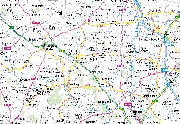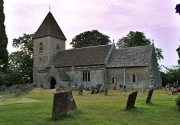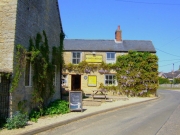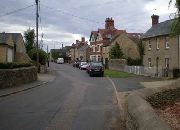Fritwell, Oxfordshire
Married here:
Thomas Cross & Mary Scasbrook (1758), William Cross & Mary Hopcroft (1787)Born here:
The eight children of Thomas & Mary, and the six children of William & Mary.Fritwell today:
Fitwell is a small village and parish about 20 kilometres north of Oxford, halfway between the market towns of Banbury and Bicester.
Fritwell is an inverted L-shaped village close to the M40 motorway. It probably owes its shape to the fact that there were, in Saxon times, two separate settlements both of which had their own manor house and were divided from each other by fields. The church was built in the eleventh century between the two settlements. Its dedication to St. Olave, the early-11th-century king of Norway, suggests that there was Danish influence before the Conquest.
The church is a stone building comprising chancel, nave, north and south aisles, western tower, and south porch. Additions and rebuilding have occured throught the centuries. In 1718 the building was desribed as 'very neat' and 'in good repair'. Minor repairs were carried out in the second half of the 18th century and in the early 19th century.
St Olave's Church had a significant role in the lives of the Cross family during the 1700s. Thomas Cross and Mary Scasbrook were married in the church in 1758 and all their eight children were baptised there, including William Cross. William, in turn, married Mary Hopcroft in 1787, and their six children were baptised in the church.
The 1801 census records show that the population of Fritwell was 396. Despite agricultural depressions in the 1800s the population rose steadily and by 1891 there were 560 residents. Besides agricultural workers there were tradesmen and craftsmen in the village at this time but by 1931 the population had dropped to 452.
Apart from the usual village craftsmen Fritwell has had a succession of clockmakers. In the 17th century there was George Harris (1614-94), a clockmaker of repute; in the mid-18th century and early 19th century there was Thomas Jennings, followed by William Jennings. Quarrying and brick-making were also local occupations. The size of the village encouraged an increase in craftsmen and tradesmen. In the 1850's there were three public houses and a number of shops. Craftsmen included a straw-bonnet maker, a harness-maker, a cordwainer, a maltster, and a brazier. Lace-making was a considerable home industry and several lacemakers were recorded in the 1851 census.
Fritwell today is a thriving community in spite of its proximity to the motorway which gives easy access to both Birmingham and London.
The village is known for the number of its well-preserved 17th-century houses. They are mostly two-story houses, built of the local rubble stone, and many have stone-slate roofs. The Vicarage, enlarged in 1933, is a good example: it is built on an L-shaped plan, and on the first floor retains its original windows with wooden mullions. Its ancient tithe barn still stands. The 'King's Head' is another 17th-century house, although much restored. Seventeenth-century cottages also survive, some with thatched and some with stone-slate or Welsh slate roofs. One is dated 1637.1
Other links of interest:
The Fritwell Conservation Area Appraisal (2008) is an appraisal of the special qualities of Fritwell village which need to be preserved and enhanced. This fascinating document gives an excellent overview of the history and character of Fritwell, with maps and photographs. Recommended.
References:
- A fuller history of Fritwell is available in 'Parishes: Fritwell', A History of the County of Oxford: Volume 6 (1959), pp. 134-146



